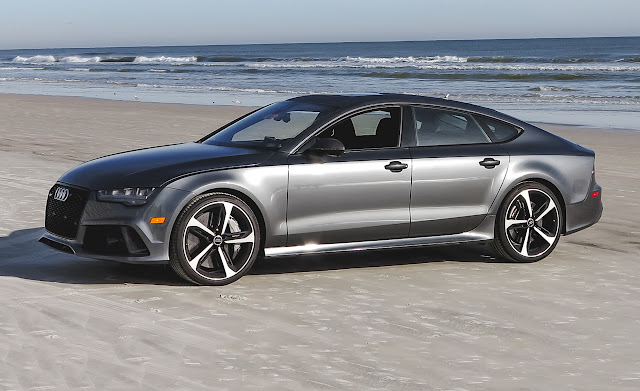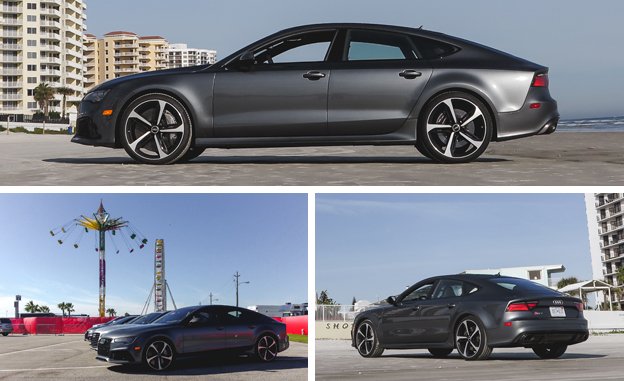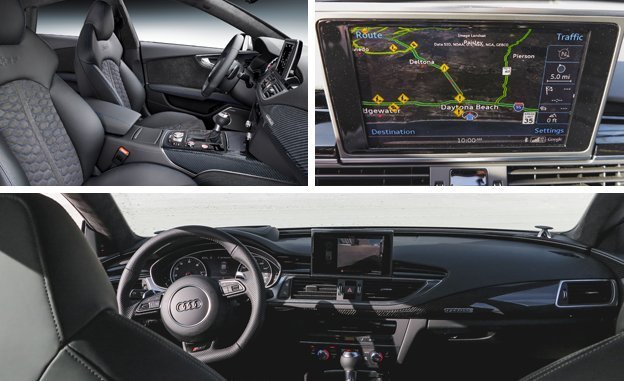We really, really like the Audi RS7—like, if we went to grade school with it, we’d pass it love notes until we ran out of paper. The RS7 is the ne plus ultra member of a lineup that also includes the A7 and S7 that earned spots on our 10Best Cars lists in 2012, 2013, and 2014—cars that remain our top picks in the curious luxury-four-door-coupe segment. For more proof of our crush, the RS7 also won the only C/Dcomparison test in which it participated. But that comparo occurred a long time ago in car years—more than two!—and Audi has since updated the model for 2016, mostly with cosmetic tweaks and technology enhancements. Its greatnessled us to call the latest model “one of the greatest performance sedans (well, hatchbacks) of all time.”
And now there’s a new top-spec version, the RS7 Performance, that has 45 more ponies under the hood and a slew of sporty fillips. Spoiler alert: We fell hard for this one, too.
The smooth 4.0-liter twin-turbo V-8 in the RS7 Performance produces a robust 605 horsepower, just five fewer than the 5.2-liter V-10 in the blazing-fast R8 supercar, as a matter of fact. Its 553 lb-ft of torque outmuscles the R8 by 140 lb-ft and the non-Performance RS7 by 37. The extra output comes mainly from a new overboost function and different turbocharger turbines, but the Performance’s V-8 also has revised valve timing, new exhaust valves, different camshafts, higher-efficiency radiators, and a reprogrammed control unit. (The new S8 Plus has the same 605-hp engine, but that car is tuned more for refinement versus the more-frenetic RS7.) As you’d expect, then, there’s plenty of thrust available, all the time, and it’s impossible to keep from grinning like an idiot during high-speed passing maneuvers and full-throttle romps away from stoplights. Zipping around sweeping on-ramps is fun, too, the lovely perforated steering wheel transmitting strong signals of the relationship between the meaty front tires and the pavement.
The eight-speed automatic—remapped for this amped-up application—is an eager accomplice. Few paddle-shifted cars compel us to use their paddles, but the RS7 is a different beast; it’s highly satisfying to have this excellent drivetrain at your direct command. The transmission shifts instantly when you thwack the appropriate paddle, and the engine roars like a wild animal, fierce and alive. Upshifts just mean more velocity piling onto the speedometer, all the way up to a stated top speed of 190 mph. Downshifts are just as scintillating, the needle flinging up the tach and the exhaust burbling viciously.
The RS7 Performance comes standard with the sport exhaust that’s optional on the 560-hp RS7. That less-powerful RS7 will continue to be available, and Audi of America execs figure the sales split will be 50/50. The $20,100-dearer RS7 Performance is actually a good deal, since it comes with carbon-ceramic brakes that aren’t available on the base car, as well as some tasteful aesthetic upgrades and the delectable engine alterations.
One note: As is sort of a trend of late—witness Dodge’s two-key strategy for its Hellcat products—the RS7 doesn’t allow its full fury to be accessed right away. One must be in Dynamic mode and/or have the transmission in the manual or sport positions in order to dip into the full 605 horses. Doing so also makes the throttle tip-in pretty touchy, so you might want to keep it in the 560-hp mode if, say, you’re shuttling your in-laws home from dinner. The Performance also gets Dynamic Ride Control suspension (DRC), which is part of the $3500 Dynamic package on the regular RS7 and trades out that car’s air suspension for sportier steel springs. The DRC dampers are connected diagonally across the car with hydraulic fluid, notably improving attack angles during cornering. The RS7 is the only current Audi with DRC, although we’ve previously experienced it in the RS4, RS5, and RS6.
According to Stephan Reil, head of technical development at Audi’s Quattro GmbH performance division, the DRC suspension would help the RS7 circle the Nürburgring three or four seconds quicker than an RS7 on air springs. Factor in the extra horsepower, he says, and the RS7 Performance should turn in a time five to seven seconds quicker than the base RS7. When pressed, Reil says the ’Ring time would be “way under eight minutes—about seven-fifty.”
Audi reckons the Performance model is one-tenth of a second quicker to 60 mph, so 3.6 seconds versus 3.7. The only time we strapped our test equipment to an RS7, during that 2013 comparison test, we posted a 3.4-second time. So yeah, this car certainly did not need another 45 horsepower. It did need better chassis control—as we noted after putting an RS7 through our Lightning Lap gantlet—and the DRC suspension certainly helps in that regard.
Speaking of racetracks, we got to try the über-RS7 on the Daytona International Speedway road course on the day before the Rolex 24. Without breaking a sweat, the RS7 cracked 135 mph on the backstretch before the Bus Stop chicane and held 115 mph on the high-banked turns. The RS7 had a lot more in it, but we’re willing to push a car only so hard on our first-ever lap on any circuit. We begged—unsuccessfully—for more track time, which also would have meant even more time with the car. After all, we really, really like the Audi RS7. Add this to the stack of love notes.











0 commentaires:
Enregistrer un commentaire